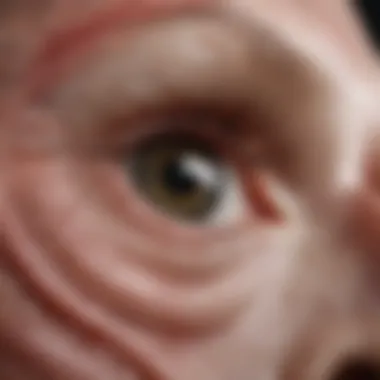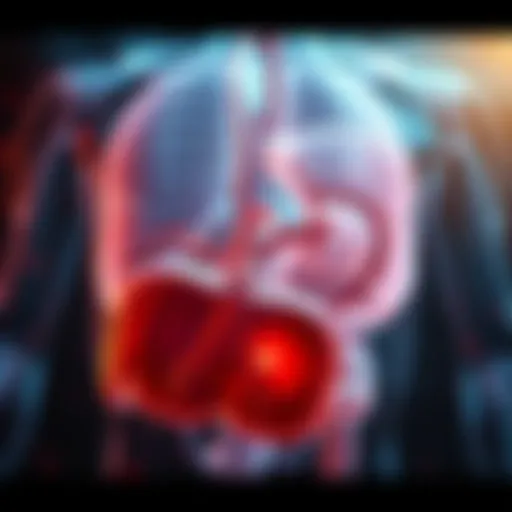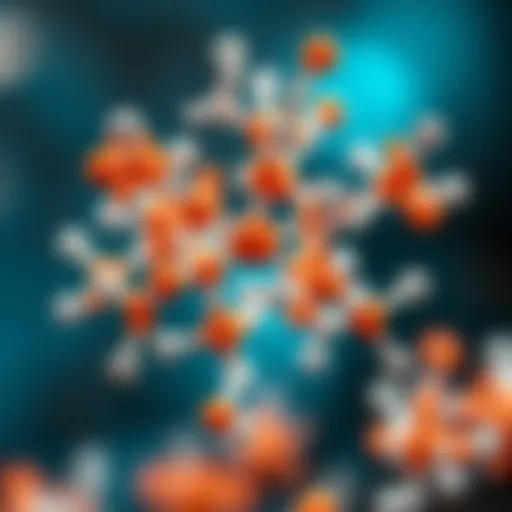Pegasos Tissue Clearing in Biological Research


Intro
In recent years, the field of biological research has witnessed remarkable advancements in visualization techniques that enable deeper understanding of complex biological systems. Pegasos tissue clearing represents a significant breakthrough in this domain, providing researchers with improved methods to observe the morphology of biological tissues. This innovation not only aids in neuroscience, pathology, and developmental biology, but also boosts the accuracy of vital experimental outcomes.
Research Background
Overview of the Scientific Problem Addressed
Biological tissues are often intricate in nature, making traditional methods of observation challenging. Conventional techniques frequently fail to provide a clear view of the internal structures within tissues. This limitation hinders the ability to study essential processes such as development, disease progression, and neural connectivity.
Historical Context and Previous Studies
Previously, several tissue clearing methods have been established, including CLARITY, SeeDB, and 3DISCO. Each of these approaches has its advantages, yet they also come with drawbacks such as time-consuming protocols or limited tissue types that can be cleared.
Pegasos has emerged as a response to these challenges, offering enhanced performance and capable protocols tailored for a broader range of tissue types. The optimization of various aspects of Pegasos tissue clearing, from clearing agents to imaging techniques, has led to its rising popularity in laboratories focusing on hiqh-quality imaging of biological samples.
Findings and Discussion
Key Results of the Research
Early applications of Pegasos tissue clearing yielded promising results in various research areas. Neuroscience has particularly benefited, allowing for detailed imaging of neuronal pathways. Moreover, studies have shown that Pegasos significantly reduces the time and effort required to clear samples compared to traditional methods.
Interpretation of the Findings
The improvements offered by Pegasos reinforce its potential as a tool for understanding biological processes. For instance, its application in pathological studies can reveal how diseases alter normal tissue structures, providing critical insights for therapeutic development. Researchers can visualize the connections between cells and their environment more clearly, which may lead to new discoveries in developmental biology as well.
"Pegasos tissue clearing provides unprecedented clarity in biological imaging, enhancing our capacity to explore hidden complexities of tissues."
Prolusion to Tissue Clearing
Tissue clearing emerges as a critical technique in biological research, enabling scientists to visualize the intricate architectures of biological tissues. As research demands more detailed insight into tissue structure and function, the significance of tissue clearing grows. It removes light-scattering components, allowing for better imaging of biological specimens. This capability is invaluable across domains such as neuroscience, pathology, and developmental biology. In this article, we will delve into Pegasos tissue clearing, showcasing its advancements, methodologies, and various applications.
Historical Context
The journey of tissue clearing techniques in biological research has evolved significantly over recent decades. Initially, traditional methods such as ethyl cinnamate and BABB offered limited success, with challenges surrounding clarity and structural integrity. However, these pioneering attempts set the groundwork for more advanced techniques. The introduction of CLARITY in the early 2010s heralded a new era, emphasizing the potential of hydrogel-based clearing methods. The breakthrough continued with subsequent developments, leading to the emergence of Pegasos. This method triumphantly addresses many limitations experienced by earlier techniques, enabling deeper exploration of complex biological systems.
Importance in Biological Research
Understanding biological samples' structures at a cellular level is crucial for numerous scientific inquiries. Tissue clearing enhances this understanding by making tissues transparent, thus facilitating imaging methods like confocal microscopy and light-sheet microscopy. With Pegasos, researchers can achieve high clarity, penetrating deeper into tissues while maintaining molecular integrity. This is particularly beneficial in areas such as:
- Neuroscience: Visualization of neural networks can inform studies on brain function and pathology.
- Pathology: Clear tissue samples allow for more accurate tumor analysis and disease diagnostics.
- Developmental Biology: Observing embryonic developments helps decipher processes that comprise growth and differentiation.
Moreover, the speed and efficiency with which Pegasos processes samples shot advancements in research timelines, saving valuable time while enhancing output quality. Hence, the importance of tissue clearing, specifically through the Pegasos approach, cannot be overstated. It stands as a catalyst in pushing the boundaries of our knowledge in biological sciences.
Overview of Pegasos Tissue Clearing
Tissue clearing has become a vital technique in contemporary biological research, particularly for understanding complex structures of biological tissues. Pegasos tissue clearing represents a significant leap in the evolution of these techniques, promising sharper imaging and enhanced clarity. Understanding this innovative approach is essential for students, researchers, educators, and professionals attracted to advancements in microscopy and tissue analysis.
Definition and Concept
Pegasos tissue clearing refers to a specific method designed to enhance the visualization of biological samples by rendering them transparent. This technique allows researchers to observe intricate details within tissues without the need for invasive procedures.
The core concept of Pegasos is to utilize a combination of refractive index matching agents and tissue preparation protocols that effectively reduce light scattering. This enables clearer imaging through conventional fluorescence or light microscopy systems. By optimizing the transparency of even large biological specimens, Pegasos tissue clearing helps reveal cellular architectures that would typically remain hidden through traditional techniques.
Mechanism of Action
The mechanism of Pegasos tissue clearing leverages a blend of chemical agents and physical state adjustments to achieve its results. The process generally begins with the fixation of biological tissues using formaldehyde or other suitable fixatives. This step is crucial for preserving cellular structures.
Following fixation, the samples undergo a series of treatments involving refractive index matching solutions. One of these solutions is a proprietary formulation that actively penetrates tissue matrices and replaces the water content within cells. As water is replaced with these clear agents, the optical properties align more favorably for imaging.
Factors contributing to the effective clearing in Pegasos include:
- Water Replacement: Substituting water within the tissue matrix reduces light scattering.
- Chemical Agents: Specific combinations of solvents help maintain morphology while facilitating transparency.
- Time-Temperature Relationships: The duration and temperature during the clearing significantly influence the efficiency of the process.
Ultimately, these steps converge in creating samples that allow for high-resolution imaging, giving researchers unprecedented access to the spatial organization of tissues at cellular and sub-cellular levels.
Methodology of Pegasos Tissue Clearing
The methodology of Pegasos tissue clearing plays a significant role in enhancing biological research. This approach revolutionizes how scientists visualize intricate structures within biological specimens. By providing a clear and detailed view of tissues, researchers can gain insights into their organization and functionality. The technique stands out due to its efficiency and effectiveness, making it a preferred choice in numerous studies. Understanding the protocol and materials involved is essential for accurate implementation.
Step-by-Step Protocol
The following provides a structured step-by-step protocol for Pegasos tissue clearing. It is important to adhere to these steps to achieve optimal results:
- Sample Preparation: Begin by obtaining biological samples, such as brain tissues or embryos. Fixation must be conducted using a suitable agent to preserve structures. Common options include paraformaldehyde or formalin.
- Clearing Agent Application: Apply the Pegasos clearing reagent directly to the tissue sample. Ensure that the sample is fully submerged to facilitate even penetration. The agent allows lipids and proteins to be removed effectively.
- Incubation: Place the sample in a controlled environment. A standard incubation time is typically between 24 to 48 hours, but this can vary depending on the thickness of the sample and the desired level of clarity.
- Rinsing: After incubation, rinse the tissue in phosphate-buffered saline. This step is crucial for removing excess clearing agent that may affect imaging results.
- Imaging: Once properly cleared, the tissue can be mounted for imaging. Utilize confocal or multi-photon microscopy to achieve high-resolution images.
- Data Analysis: Analyze the acquired images using advanced software. Quantitative measures can yield information on structural changes or specific tissue characteristics.
Following this protocol allows researchers to visualize biological tissues in a way that was not previously possible, aiding in various scientific inquiries.
Materials Required
To successfully implement Pegasos tissue clearing, the following materials are necessary:


- Biological Samples: These can include neural tissues, organs, or embryos, depending on the research focus.
- Clearing Reagents: The key component is the Pegasos clearing agent. Researchers must ensure the agent is appropriately prepared.
- Fixatives: Paraformaldehyde or formalin serves as effective fixatives to preserve sample integrity prior to clearing.
- Microscopy Equipment: High-resolution imaging systems, such as confocal or multi-photon microscopes, are critical for visualizing cleared samples.
- Phosphate-Buffered Saline (PBS): This buffer is required for rinsing the cleared specimens to remove residual clearing agent.
Having these materials readily available ensures a smoother workflow during the clearing process, ultimately leading to successful outcomes in imaging and analysis.
Comparative Analysis with Traditional Clearing Techniques
The examination of Pegasos tissue clearing in relation to traditional clearing methods is essential for understanding its significance and impact in biological research. Traditional techniques, such as the Babbitt method or the CLARITY protocol, have laid the groundwork for tissue imaging, but they often come with certain limitations regarding efficiency, clarity, and compatibility with various types of biological samples. By contrasting Pegasos tissue clearing with these conventional methods, researchers can appreciate the advancements and possibilities offered by this innovative approach.
Efficiency Metrics
Efficiency in tissue clearing techniques refers to the speed and effectiveness of the process in producing permeable, transparent tissues suitable for imaging. Pegasos technology stands out with its rapid protocol, allowing researchers to clear samples in a fraction of the time needed for traditional methods, which can take days. This efficiency is crucial in time-sensitive research settings, where swift results are often required.
Moreover, Pegasos tissue clearing utilizes an optimized reagent composition, enhancing the penetration of clearing agents into tissues. The result is a minimal loss of structural integrity while maintaining the original properties of the sample. An essential aspect of efficiency metrics is also the volume of reagent used. Pegasos requires less reagent than many traditional methods, thus offering a cost-effective solution that can be scaled up for larger studies without sacrificing quality.
Effective clearing methods not only enhance visualization, but they also streamline research workflows and reduce resource consumption.
Quality of Imaging Results
The quality of imaging results produced by any tissue clearing technique is paramount. High-resolution imaging is vital for accurately visualizing complex biological structures. In comparative studies, Pegasos has been shown to produce superior results in imaging depth and clarity compared to some traditional methods. While traditional methods often struggle with signal loss due to scattering or absorption within thick tissues, Pegasos minimizes these issues through its optimized formulation.
In many cases, researchers have found that Pegasos provides crisp, high-quality images that reveal intricate details of cellular structures. This is particularly important in fields such as neuroscience, where observing fine neuronal structures is crucial for understanding functions and disorders.
Furthermore, the compatibility of Pegasos with various imaging modalities, such as light sheet fluorescence microscopy, enhances its versatility. Traditional clearing methods may not provide the necessary transparency for optimal imaging conditions across different platforms, thus limiting their applicability.
In summary, the comparative analysis of Pegasos tissue clearing against traditional techniques reveals significant advancements in both efficiency and the quality of imaging results. These enhancements facilitate deeper insights into biological tissues, paving the way for breakthroughs in research across multiple fields.
Applications in Neuroscience
The applications of Pegasos tissue clearing in neuroscience are profound. This technique significantly enhances our understanding of complex neural structures and their functions. By allowing researchers to visualize neural connections in previously opaque tissues, it provides pivotal insights into brain architecture and organizational hierarchies. The implications of improved imaging capabilities can lead to advancements in diagnosing and treating a variety of neural disorders.
Visualization of Neural Structures
Visualization of neural structures is crucial for neuroscientific research. Traditional methods often faced limitations in clarity and depth penetration. Pegasos tissue clearing overcomes these barriers, making it possible to render entire brain regions transparent. This enables researchers to observe the intricate wiring of neurons, investigate synaptic connections, and discern the relationships between different types of brain cells.
The ability to visualize neurons in three dimensions opens new avenues for understanding neural circuitry. This is particularly pertinent for studies involving complex behaviors, cognition, and sensory processing. With clarity provided by Pegasos, researchers can better delineate the pathways involved in various functions and how alterations may correlate with disease states.
Additionally, this technique facilitates high-resolution imaging. For example, it allows for the mapping of specific neural pathways using fluorescent markers, which can be crucial in assessing the impacts of neurological interventions.
Studying Neurodegenerative Diseases
Studying neurodegenerative diseases is another crucial application of Pegasos tissue clearing. These conditions, such as Alzheimer’s and Parkinson’s disease, challenge scientists due to their complex pathophysiology. The ability to visualize affected neural structures helps in understanding the progression of these diseases.
With the enhanced transparency achieved through Pegasos, researchers can examine brain samples from patients with neurodegenerative disorders in great detail. They can identify the specific regions affected, characterize the extent of tissue loss, and observe the accumulation of pathological proteins. This is instrumental in discovering biomarkers that indicate disease progression.
Moreover, as new therapies are developed for neurodegenerative conditions, Pegasos tissue clearing will serve as a valuable tool to evaluate their efficacy. By providing a clear view of affected neurons before and after treatment, it allows for an assessment of how treatments alter disease pathology.
"Pegasos tissue clearing represents a leap in our capacity to study both normal and abnormal neural processes, potentially transforming therapeutic approaches."
Applications in Developmental Biology
The relevance of Pegasos Tissue Clearing in developmental biology is profound. This innovative technique provides researchers with unparalleled clarity in visualizing the intricate architectures of developing tissues. The application of Pegasos allows for thorough studies into how tissues form and change, yielding valuable insights into developmental processes and mechanisms. Its ability to make previously opaque biological samples transparent opens avenues for exploration that traditional methods simply cannot offer.
Embryonic Development Studies
Studying embryonic development is essential for understanding the foundation of life. Important aspects such as cell differentiation, tissue organization, and organ formation can be investigated more comprehensively with Pegasos tissue clearing. This method enhances the visualization of embryonic structures, enabling researchers to follow cellular behaviors during critical developmental windows.
- It reveals the 3D spatial relationships between cells and tissues.
- Allows tracking of gene expression patterns in embryonic stages, which is crucial for understanding congenital disorders.
- Facilitates the study of molecular interactions that dictate developmental fates.
By using this technology, researchers can address critical questions regarding how genetic and environmental factors influence early development. For instance, understanding the development of the neural tube is pivotal for discerning the mechanisms behind neural tube defects.
Tissue Morphogenesis
Tissue morphogenesis involves complex interactions between cells that lead to the formation of organized structures. Pegasos tissue clearing plays an essential role in elucidating these processes. This method permits the detailed examination of how tissues change shape and arrangement over time.
- Researchers can visualize the dynamic changes in tissue architecture during stages such as growth and regeneration.
- It aids in analyzing the role of mechanical forces in shaping tissues, which is vital for understanding various developmental pathways.
- Morphogenetic movements can be observed in real-time, allowing for the tracking of critical morphogenetic events.
In summary, the application of Pegasos tissue clearing in developmental biology not only enhances the depth of studies related to embryonic development but also provides clarity in watching how tissues morph and organize themselves throughout development. This aligns with the objective of understanding fundamental biological processes, which could lead to advancements in regenerative medicine and developmental biology as a whole.
Applications in Pathology
The relevance of Pegasos tissue clearing in pathology is profound. This innovative technique offers not only enhanced visualization of tissues but also crucial insights into various pathological conditions. Understanding disease processes at the tissue level is essential for accurate diagnosis and effective treatment strategies.
Pegasos tissue clearing allows researchers to observe the complex architecture of tissues. This is vital in pathology where the relationship between cellular structures and disease manifestations is significant. Enhanced imaging capabilities enable the identification of tumors and infectious agents at a previously unattainable resolution.
Tumor Analysis
In tumor analysis, Pegasos tissue clearing provides a detailed view of both tumor morphology and microenvironment. Traditional methods often limit the visibility of the three-dimensional structure of tumors, whereas this technique reveals intricate details. This becomes particularly important in understanding tumor heterogeneity and invasion patterns, which are critical for effective treatment planning.
Research shows that deep imaging of cleared tissues can uncover unique cellular interactions within the tumor microenvironment. For instance, by visualizing how cancer cells interact with surrounding immune cells, researchers can develop more targeted therapies. Moreover, Pegasos enhances the ability to assess treatment responses. Monitoring the changes in tumor structure can lead to improved strategies for personalized medicine.
Infectious Disease Research
The role of Pegasos tissue clearing in infectious disease research cannot be understated. This method enables scientists to visualize the extent and dynamics of infectious agents within host tissues in great detail. By providing a complete view of the infection's progression, this technique facilitates a better understanding of pathogen behavior and immune responses.


For example, researchers can observe how bacteria or viruses disseminate through tissues, helping to identify potential reservoirs or pathways of infection. This information is vital for developing vaccines or treatment strategies. Furthermore, the ability to clearly visualize such interactions leads to improved models of disease spread and pathology.
Technical Challenges in Pegasos Tissue Clearing
The development and implementation of Pegasos tissue clearing have marked significant progress in biological research. However, like any innovative technique, it brings a set of technical challenges that researchers must navigate. Understanding these challenges is crucial for maximizing the efficacy of Pegasos tissue clearing and ensuring reliable results. This section will explore these challenges, focusing on the limitations of current techniques and providing strategies for troubleshooting common issues.
Limitations of Current Techniques
While Pegasos tissue clearing offers many advantages, it is not without limitations. Some of the most pressing issues include:
- Reproducibility Concerns: Variability in results can occur due to differences in sample preparation, including variations in the type and quality of biological tissues used.
- Chemical Toxicity: The reagents involved, although effective, can be toxic to certain types of cells. This limits the types of biological samples suitable for this method.
- Time-intensive Processes: The procedure, while faster than some traditional clearing methods, still requires meticulous attention to detail, which can slow down high-throughput studies.
- Limited Tissue Penetration: The effectiveness of Pegasos in penetrating dense tissues can vary, impacting the resultant image quality.
Addressing these limitations is essential for improving the reliability and applicability of Pegasos tissue clearing in diverse biological contexts.
Troubleshooting Common Issues
During the application of Pegasos tissue clearing, researchers may encounter several common issues that can affect the outcomes of their studies. Some key troubleshooting strategies include:
- Variability in Transparency: If tissues do not reach expected transparency, check the reagent concentrations and ensure proper incubation times.
- Poor Imaging Results: In cases where imaging yields unclear results, verify the compatibility of the chosen imaging technology with the cleared sample.
- Sample Integrity: If samples are suffering damage during the clearing process, it may be beneficial to revisit sample preparation methods and optimize them based on tissue type.
Effective troubleshooting requires not only technical skills but also a deeper understanding of the biological materials involved.
By being proactive in addressing these challenges and understanding their implications, researchers can better harness the potential of Pegasos tissue clearing. This ensures that the advancements and applications of this technique continue to contribute meaningfully to the field of biological research.
Optimization Strategies
The significance of optimization strategies in Pegasos tissue clearing lies in their potential to enhance the overall effectiveness of the technique. While Pegasos represents a step forward in the field of biological imaging, the complexities involved require careful consideration to achieve optimal results. This section will explore enhancing transparency and clarity, maximizing signal retention, and other pertinent elements that contribute to successful outcomes in research applications.
Enhancing Transparency and Clarity
Achieving high levels of transparency and clarity in biological samples is paramount. The first step involves selecting the right clearing agents. For Pegasos tissue clearing, agents like the proprietary Pegasos solution are designed to effectively remove lipids while preserving proteins and nucleic acids. Careful attention must be paid to the concentration and exposure time, as overexposure can lead to sample degradation.
Another technique to consider is the optimization of incubation temperatures. Warmer temperatures can enhance the penetration of clearing agents into thick tissues but may risk damaging sensitive structures. Therefore, finding a balance is crucial.
It is also important to perform iterative transparency assessments. By utilizing imaging technologies such as confocal microscopy at various points during the clearing process, researchers can gain insights into how transparency improves over time. This ensures that the sample reaches optimal clarity before further analysis.
Maximizing Signal Retention
Signal retention refers to the preservation of fluorescence or other imaging signals during the clearing process. Retaining signal integrity is essential for obtaining accurate and meaningful images. To maximize signal retention, researchers can consider the following approaches:
- Fluorophore Selection: Choosing robust fluorophores that are less prone to photobleaching can positively impact outcomes.
- Optimized Fixation Protocols: Ensuring that tissues are properly fixed prior to the clearing process can help maintain the structural integrity and fluorescence of the sample. Common fixatives include paraformaldehyde, but alternatives can yield varying results.
- Controlled Clearing Conditions: Maintaining an optimized ratio of clearing agents to biological material can minimize the loss of fluorescent signals. Finding the right conditions can be challenging but essential.
"Effective optimization not only leads to clearer images but also allows for more precise data interpretation in biological studies."
Furthermore, continuous monitoring during the process allows for prompt adjustments. Regularly examining the samples and correlating both clarity and signal strength can lead to improved methodologies. By prioritizing both clarity and signal retention, researchers can ensure that the Pegasos tissue clearing technique achieves its full potential in biological research.
Future Directions in Tissue Clearing Research
Research in tissue clearing, especially Pegasos tissue clearing, is advancing rapidly. Understanding the future trajectories in this area is crucial for researchers to stay informed about potential breakthroughs. As technology evolves, so do methodologies. The integration of Pegasos with emerging imaging technologies presents significant opportunities for enhancing biological research.
Continued development in this field can facilitate better access to previously hidden details in biological samples. This knowledge can lead to more comprehensive studies in areas such as neurology and oncology, which depend heavily on the visualization of tissue structures. The interplay between improved techniques and their applications can unlock novel insights into complex biological processes.
Improvements in Methodology
Methodological advancements are central to enhancing the efficacy of Pegasos tissue clearing. Several elements should be considered. Focus on refining chemical formulations can potentially enhance tissue transparency without compromising molecular integrity. One area of improvement is the balance between clearing agents and their effects on cellular architecture. Choosing the right substances can minimize distortions in tissue morphology, which is critical for accurate interpretation of images.
Moreover, optimizing the clearing process itself is essential. Current procedures could often be streamlined. Automating procedural steps can reduce human error and speed up research timelines. Researchers must prioritize fine-tuning time and temperature conditions during the clearing process. Studies show that slight adjustments in these parameters can significantly affect the end-result, making it imperative to explore diverse approaches.
Lastly, the consideration of different tissue types and their unique characteristics can allow for tailored methodologies. A one-size-fits-all approach may not work. Therefore, pursuing research on specific applications for varied biological materials is advantageous and necessary for progress in this area.
Integration with Imaging Technologies
As we look toward the future, the integration between Pegasos tissue clearing and advanced imaging technologies is highly promising. Innovative imaging techniques like light-sheet microscopy and multi-photon microscopy can greatly benefit from enhanced tissue transparency provided by Pegasos. The combination of these methods can provide high-resolution images that were previously unattainable.
Utilizing high-speed imaging platforms can facilitate the observation of dynamic biological processes in real-time. Researchers can gather data on cellular interactions and tissue responses in ways that were once considered impossible. Additionally, artificial intelligence and machine learning can support the analysis of imaging data, leading to quicker and more insightful interpretations. This technology may assist in identifying patterns and anomalies that require further investigation.
Furthermore, collaboration between experts in tissue clearing and imaging technologies can accelerate developments. Sharing knowledge and tools can push the boundaries of what is currently known about biological systems. Strategies for integrating these technologies into standard laboratory practices need to be explored, ensuring that researchers have access to the most potent techniques available.
"Collaboration between different fields can foster innovation and lead to significant advancements in research methodologies."
In summary, the future of tissue clearing, particularly through the lens of Pegasos, holds exciting possibilities. Focusing on methodologies and technology integration is key to unlocking new aspects of biological research. As this area continues to develop, researchers must remain flexible and responsive to change, ready to adapt to new findings and technologies.
Ethical Considerations in Tissue Clearing
As biologists and researchers venture deeper into tissue clearing techniques like Pegasos, the moral and ethical dimensions of their practices cannot be overlooked. The advent of powerful visualization methods brings forth numerous benefits, but it also raises significant ethical issues that must be navigated carefully.
Regulatory Compliance
In the realm of tissue clearing, adhering to regulatory compliance is paramount. Different regions have various guidelines that govern the handling of biological samples. These regulations are in place to ensure the ethical sourcing of specimens and the protection of both human and animal rights. Researchers must remain vigilant about these laws, which may include obtaining informed consent for human-derived tissues and following strict protocols for animal welfare. This compliance not only safeguards researchers legally but also maintains the integrity and public trust in scientific inquiry. Understanding local and international regulations provides a framework within which research can proceed ethically. This emphasis on compliance fosters a culture of responsibility in the scientific community, ultimately promoting advancements that can benefit society.
Impact on Biological Samples


The impact of tissue clearing techniques on biological samples is another critical consideration. Pegasos tissue clearing enhances visualization significantly, which is a notable advancement. However, the processes involved in some clearing methods can alter the structural integrity of samples. Researchers must be aware of how these procedures may affect cellular morphology, protein localization, and overall tissue architecture. These changes can lead to misinterpretation of results, ultimately skewing data and compromising research validity.
Moreover, the long-term effects on samples that undergo clearing should be systematically studied. This could include evaluating potential cytotoxic effects from chemicals used in the clearing process. Performing rigorous assessments can mitigate risks and ensure that findings derived from these samples are reliable and robust.
"Ethical scrutiny in tissue clearing is essential. It helps in aligning scientific exploration with society's moral compass and brings clarity to complex biological inquiries."
Community Impact and Collaboration
The role of community impact and collaboration in the context of Pegasos tissue clearing is substantial. The advancements made in this field do not happen in isolation; they thrive on collective knowledge and shared resources. Collaboration among researchers, institutions, and open-source communities leads to the faster evolution of techniques. The implications for biological research are profound as sharing methods and findings can improve the efficacy and reach of tissue clearing applications.
Benefits of Community Engagement
Engaging with a community provides numerous advantages. A few key benefits include:
- Shared Knowledge: Researchers can learn from each other's experiences and challenges, leading to better protocols and innovative solutions.
- Resource Availability: Accessible resources, such as protocols and materials, can significantly reduce the costs and time associated with tissue clearing projects.
- Standardization: A collaborative community can work towards standardized methods in Pegasos tissue clearing, ensuring reproducibility and reliability in results.
"Collaboration fosters an environment where creativity and experimentation can flourish, ultimately benefiting the entire scientific community."
These facets not only facilitate individual research but also drive systemic growth across various scientific sectors.
Open Source Initiatives
Open-source initiatives represent a powerful dimension of community collaboration. They foster an inclusive environment where researchers can share discoveries, methods, and even software that supports Pegasos tissue clearing. This model allows individuals and institutions, regardless of their resources, to participate in cutting-edge research.
Examples include:
- Publication of Protocols: Many researchers publish their protocols openly, enabling others to replicate and build upon their work. This accelerates progress by reducing duplication of effort.
- Software Tools: Development of data analysis software, such as Fiji or ImageJ plugins for image processing, further democratizes access to advanced research tools used in conjunction with Pegasos techniques.
- Online Repositories: Platforms like GitHub allow researchers to contribute code or tools relevant to tissue clearing, inviting feedback and improvements from the community.
Collaborative Research Efforts
In addition to open-source initiatives, collaborative research efforts play a crucial role in advancing the applications of Pegasos tissue clearing. When teams from different backgrounds come together, diverse perspectives enhance problem-solving and innovation.
Consider the following elements of successful collaborative research:
- Interdisciplinary Teams: Collaborations among neuroscientists, pathologists, and engineers often lead to enriched methodologies that leverage strengths of different fields.
- Joint Funding Projects: Shared funding initiatives enable researchers to pool resources for large-scale studies that may be unfeasible individually. These collaborations can lead to groundbreaking findings that advance the entire field of biological visualization.
- Conferences and Workshops: Events dedicated to tissue clearing allow researchers to meet, discuss, and merge ideas. Presentations of ongoing projects stimulate collaboration and help create networks that last beyond the event itself.
In summary, the focus on community impact and collaboration emphasizes the collective effort required to advance Pegasos tissue clearing. By sharing knowledge, resources, and pursuing joint initiatives, the scientific community can overcome challenges more effectively, driving innovation and enhancing applications within biological research.
Tools and Resources for Researchers
Access to effective tools and resources is vital for researchers working with Pegasos tissue clearing. This technique requires a specific set of protocols, manuals, and community support to ensure successful application. Researchers must familiarize themselves with the available tools while understanding their functionalities. The efficiency and accuracy of tissue clearing depend significantly on how correctly these resources are utilized.
Accessing Protocols and Manuals
Protocols and manuals are essential documents that outline step-by-step methods for implementing Pegasos tissue clearing. They serve as comprehensive guides for both novice and experienced researchers. These resources typically include necessary materials, processes, and troubleshooting tips. By providing detailed instructions, protocols help minimize errors and maintain consistency in experimental results.
Researchers can find these protocols in various places, including:
- Institutional Repositories: Many universities and research institutions have their own databases where researchers can access protocols developed within their programs.
- Scientific Journals: Often, researchers publish their methodologies in peer-reviewed journals. This can be a reliable source of validated protocols.
- Online Databases: Websites like ResearchGate and specific biological databases host materials that researchers can download and utilize.
Ensuring proper access to these documents is fundamental. Researchers should focus on those protocols that detail their specific experiments relevant to Pegasos tissue clearing to maximize their resource utility.
Online Communities and Forums
In addition to formal protocols, online communities provide an invaluable support network for researchers. These platforms enable sharing of knowledge, experiences, and troubleshooting advice among peers. Forums dedicated to biological research create an environment where users can ask questions, share discoveries, and improve their techniques.
Several notable online communities include:
- Reddit: Subreddits related to tissue clearing and biological research offer discussion threads for problem-solving and resource-sharing.
- Facebook Groups: Numerous groups focus specifically on microscopy and tissue clearing, providing a space for collaboration and communal learning.
- Dedicated Research Forums: Platforms such as BioForum and Protocol Exchange allow researchers to post their queries and receive feedback from experienced peers.
Participation in these communities can foster collaboration and accelerate the learning process. It is important for researchers to actively engage with these groups, as the information shared often reflects the latest trends and innovations in the field. Additionally, building relationships in these forums can lead to collaborative opportunities for future projects.
"Collaboration and shared resources enhance the scientific community, driving innovation and improving methodologies in research."
In summary, tools and resources are critical in streamlining the adoption of Pegasos tissue clearing. Access to comprehensive protocols and active engagement in online communities can significantly enhance the quality of research and outcomes.
Finale
The significance of the topic of tissue clearing is evident in the context of modern biological research. This article highlights Pegasos tissue clearing, an innovative technique that enhances visibility of biological samples. Embracing such advancements is vital for researchers in various fields, including neuroscience, pathology, and developmental biology. Understanding the methodology and applications of Pegasos offers numerous benefits.
First, Pegasos improves the clarity and contrast in imaging, allowing for more comprehensive analysis of complex structures in tissues. This is especially useful when studying neural networks or cellular interactions in development.
Second, the optimization strategies outlined show the potential for further enhancement of results. By focusing on transparency and signal retention, researchers can push the boundaries of what is possible in tissue visualization. Efforts in improving these aspects can lead to revolutionary discoveries in fields like cancer research and neurobiology.
Lastly, this article discusses ethical considerations, regulatory compliance, and community impact. Engaging in responsible research practices ensures that the advancements made with techniques like Pegasos are sustainable and beneficial to society. Collaboration among researchers through open-source initiatives fosters an environment of shared knowledge and growth.
"Comprehensive biological investigations rely heavily on advanced visualization techniques, and Pegasos represents a significant step forward in this domain."
In summary, the future of tissue clearing, particularly with Pegasos, holds promise for advancing our understanding of intricate biological systems.
Key Takeaways
- Pegasos tissue clearing enhances the visibility of biological samples, facilitating improved imaging and analysis.
- This technique has relevant applications in neuroscience, pathology, and developmental biology, allowing deeper insights into complex tissue structures.
- Optimization strategies are crucial for maximizing the performance of clearing techniques, focusing on clarity and signal retention.
- Ethical considerations and collaboration in research are essential for ensuring responsible advancement in this field.
The Future of Tissue Clearing
The horizon looks bright for tissue clearing techniques like Pegasos. As technology advances, both methodology and applications will likely evolve. Here are some potential future directions:
- Integration with advanced imaging technologies: The combination of Pegasos with cutting-edge imaging methods, such as super-resolution microscopy, can provide even more detail in biological investigations.
- Innovative materials and solutions: Researchers are exploring new agents for tissue transparency that may enhance performance and reduce potential drawbacks.
- Broader applications in medicine: From personalized medicine to regenerative therapies, the ability to visualize tissues in greater detail can significantly impact clinical practices.
- Collaborative research platforms: As the scientific community fosters collaboration through open-source platforms, shared protocols and findings can accelerate progress in this area.
Overall, continued exploration and application of Pegasos tissue clearing promise significant enhancements in biological research.







